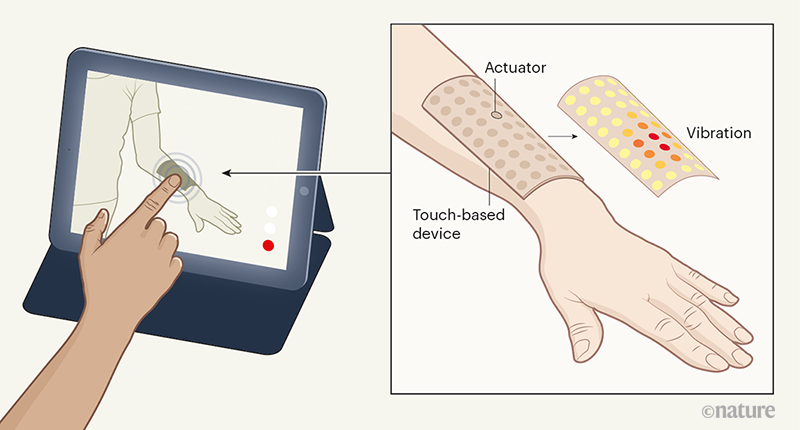Human sensation includes the commonly known senses and less-recognized ones such as thirst, hunger and balance. Stimuli detected by sensory receptors are encoded into electrical signals that move along neural pathways to specific parts of the brain to be decoded into useful information. The whole process is complex. For instance, the sense of touch is a collection of several sensations, encompassing pressure, pain and temperature, and touch receptors are stimulated by a combination of mechanical, chemical and thermal energy. Until now, it has been a great challenge to incorporate sensations of touch into virtual and augmented reality. But in a paper in Nature, Yu et al. report a skin-integrated technology that applies pressure, vibration or motion to the user, enabling communication between the user and a machine for virtual and augmented reality (X. Yu et al. Nature 575, 473–479; 2019).
The authors’ technology consists of a soft, lightweight sheet of electronics that adheres to skin, and conforms to the body’s shape, in a convenient, non-invasive and reversible manner (Fig. 1). The sheet contains arrays of vibratory actuators — mechanical components that convert electrical energy into vibrations. Each actuator comprises two connected parts: a coil of copper wire sealed in an acrylic base, and a permanent magnet mounted on a polymer beam. When an electric current passes through the coil, the magnet vibrates at the same frequency as that of the current.
Each actuator has a mass of only 1.4 grams and is millimetre-sized (12–18 mm in diameter and 2.5 mm thick). Given that human skin can detect submillimetre-scale touch patterns, one might question whether the actuators can be scaled down. The authors proposed a method to achieve such miniaturization and tested it by running simulations. They found that the diameter and thickness of each actuator could in future be reduced by a factor of ten and three, respectively.
A key feature of Yu and colleagues’ device is that its actuator arrays are wirelessly powered and controlled. It is therefore less cumbersome than wearable platforms that require connecting wires or internal batteries. The system uses a primary antenna for power transmission, a few other antennas for controlling and driving the actuators, and an intermediate antenna to boost the power harvested from the primary antenna. Yu et al. found that the inclusion of the intermediate antenna increased the collected power by a factor of about three. The authors carried out simulations to confirm that their device complies with guidelines from the US Federal Communications Commission and the Federal Drug Administration regarding safe levels of radiation exposure and tissue absorption.
The distance between the power source and the platform needs to be less than about one metre, making the technology suitable for certain applications in virtual and augmented reality. Yu et al. describe three particular examples. In the first one, a girl touches a screen that displays a video feed of her grandmother; the grandmother senses the touch through devices on her hand and arm. In the second example, a man who has a lower-arm amputation grasps an object using a prosthetic arm that has a robotic hand; a device on his upper arm generates a pattern of sensation that reproduces the object’s shape. In the third example, a person playing a combat-based video game wears several devices across their body; the devices are activated when a strike occurs on the corresponding body part of the game character.
The technology does have some drawbacks. For instance, each actuator is driven by a set current of about 5 milliamps, which is relatively high compared with that found in other consumer digital electronics. In addition, the energy lost from the other components as heat might affect actuator performance and cause warming of the skin if dissipation of the heat is not well managed. Moreover, although an optimized actuator requires only 1.75 milliwatts of power, the overall power consumption of the technology is still a key limiting factor in operating the platform sustainably and wirelessly for practical use. Miniaturization of the actuators could be a feasible way to address these issues, as the authors point out.
In 2002, many people were inspired by a smart wearable invention known as the Hug Shirt, which allows hugs to be sent over a distance with the same ease as sending a text message or chatting (see go.nature.com/32kg1oz). This technology is equipped with embedded sensors that detect and encode the strength, duration and location of the touch, together with the skin warmth and heart rate of the sender. Through wireless communication and a control circuit, these signals are decoded to control actuators that reproduce the sensation of the hug for the receiver. Both the Hug Shirt and Yu and colleagues’ device suggest that the application of touch sensations in virtual and augmented reality is just beginning, and that more exciting progress can be expected in the future.


![Buildbox Free - How To Make 2D Platformer Game [PART 1]](https://www.danielparente.net/info/uploads/sites/3/2020/01/Buildbox-Free-How-To-Make-2D-Platformer-Game-PART-150x150.jpg)


